Content
- What Nurofen helps from and when you can give medicine to a child
- The mechanism of action of the active substance
- Daily doses for children by age
- Why is it important to follow the instructions for use of the drug
- Possible causes of overdose and how to avoid it
- Signs of an overdose with Nurofen
- First aid
- Symptomatic overdose relief
- With vomiting and upset stools
- For severe headache in a child
- When the pressure drops
- In case of malfunctioning of the heart
- Possible consequences of an overdose, emergency assistance
- Metabolic acidosis
- Atrial fibrillation
- Acute renal failure
- Stop breathing
- Coma
- Video about the active substance of Nurofen
Nurofen is a drug, widely used in the therapy of adults and children. Often, the drug, if used incorrectly, can lead to the development of overdose symptoms.
What Nurofen helps from and when you can give medicine to a child
For children, the medicine is prescribed only if there are indications. The product should only be used under the guidance of a doctor and an adult (parents).
Indications:
- infections and inflammation of the ENT organs, accompanied by pain syndrome;
- headaches and toothaches;
- childhood infectious diseases;
- reactions caused by vaccinations or vaccinations.
Also, the drug can be given to a child with various other diseases, accompanied by fever and fever.
The mechanism of action of the active substance
The active substance of the drug is ibuprofen, which belongs to the group of non-steroidal anti-inflammatory drugs (NSAIDs). It has high anti-inflammatory, antipyretic and analgesic properties.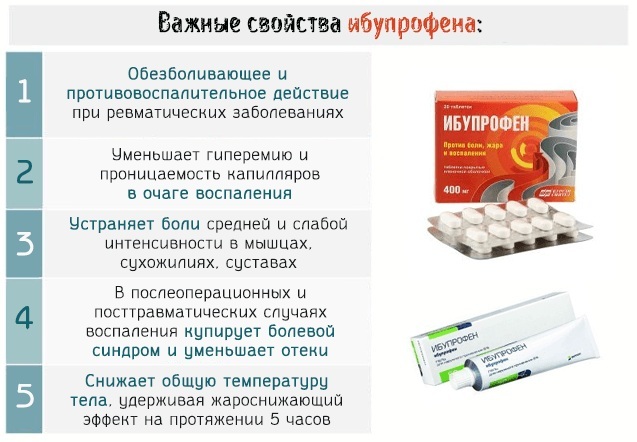
The action of the component is aimed at suppressing the activity of cyclooxygenase (COX), which is one of the varieties of prostaglandins - substances involved in the development of pain and inflammatory processes.
The analgesic effect of the drug is due to the central and peripheral action of the active ingredient. The ingredient inhibits platelet aggregation (clumping).
Daily doses for children by age
You should strictly adhere to the rules of the daily or single dosage specified in the instructions or prescribed by the attending physician.
| Child's age | Body mass | Single dosages (3 times a day) |
| From 3 months to six months | 5-7.5 kg | 0.05 g or 2.5 ml |
| From half a year to 1 year | 7.7-9 kg | 0.05 g or 2.5 ml |
| 1-3 years | 10 to 16 kg | 0.1 g or 5 ml |
| 4-6 years old | 17-20 kg | 0.15 g or 7.5 ml |
| 7-9 years old | 21 to 30 kg | 0.2 g or 10 ml |
| 10 to 12 years old | 31-40 kg | 0.3 g or 15 ml |
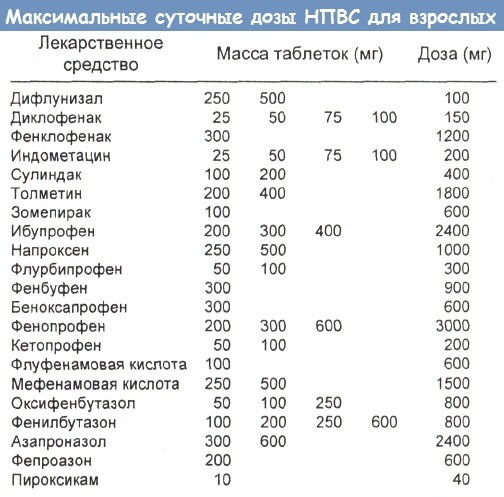
Children over 12 years of age are advised to take the dosage prescribed as for adult patients. However, before that, you should definitely consult with your doctor, since the doses depend not only on age, but also on the degree of tolerance of the drug and the physiology of the child.
Why is it important to follow the instructions for use of the drug
An overdose of Nurofen in a child occurs in extremely rare cases. However, parents need to be familiar with possible symptoms and first aid guidelines. It is imperative to observe the prescribed dosages, since the drug is hepatotoxic (has a toxic effect on the liver).
In children (especially newborns), the internal organs and the immune system are not fully formed and developed, so the medicine can lead to malfunctions in their work. At the same time, the liver and other organs are not yet able to withstand such loads, which can lead to serious consequences, including the development of chronic diseases.
Possible causes of overdose and how to avoid it
There are many different reasons why an overdose can develop.
The main ones are the following factors:
- self-medication (without first consulting a doctor);
- improper intake of the drug;
- accidental increase in the daily or single dose;
- medical error;
- lack of awareness of the rules for taking medications;
- physiological characteristics of the child's body;
- drug interaction with other drugs or incompatible substances;
- long-term use of the drug in high dosages (cumulative effect);
- decompensated forms of diseases of various organs and systems (liver, kidneys, heart, lungs).
In some cases, the development of negative symptoms may be associated with the rapid introduction of morphine, due to the treatment of pulmonary edema in the child.
Signs of an overdose with Nurofen
If the daily or single dosages are exceeded, the child may develop negative signs from various organs and systems.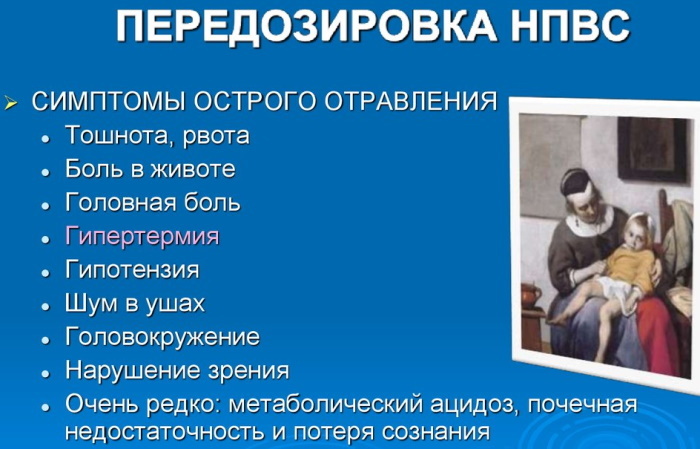
Overdose symptoms:
- pain in the epigastric region;
- nausea and vomiting;
- fast fatigue, fatigue;
- migraine;
- blurred vision (fog or double vision);
- the development of spasms in the area of \ u200b \ u200bmasticatory muscles (trismus);
- hearing impairment (ringing or tinnitus);
- lowering blood pressure;
- irregularities in the rhythms of the heart (tachycardia, bradycardia);
- depressive conditions.
In case of severe intoxication with the drug, conditions that are life-threatening to the child can develop:
- metabolic acidosis;
- acute kidney failure;
- atrial fibrillation;
- coma;
- cessation of breathing.
If these symptoms occur, you must immediately contact a specialist.
First aid
An overdose of Nurofen in a child requires immediate and immediate first aid before the arrival of an ambulance team. This will reduce the risks of developing complications and avoid consequences that are life-threatening for the child.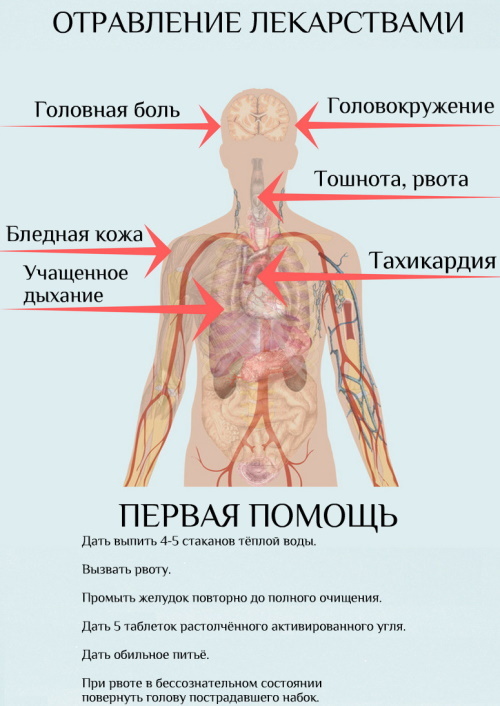
At the first signs of poisoning, it is necessary to wash the stomach (actual within the first hour). You should also consume several glasses of water or potassium permanganate (potassium permanganate), and then try to artificially induce vomiting. Actions must be carried out until the moment when the remnants of previously consumed food do not cease to come out during vomiting.
Gastric lavage for children under the age of 3 years is not carried out, as this can lead to serious consequences. The procedure must be carried out using a special probe in a medical institution.
After washing, the child is prescribed sorbing drugs:
- Activated carbon;
- Smecta;
- Polysorb;
- Atoxil.
This will stop the absorption of the components of the medication into the intestines and blood.
An important point in case of drug overdose is drinking plenty of fluids, which will reduce the concentration of the drug in the blood and, thereby, reduce the toxic effect on the body.
It is recommended to use plain or mineral water as a drink. When drinking plain water, it is recommended to add a little salt or baking soda to it beforehand. The drug does not have a specific antidote.
Symptomatic overdose relief
Symptomatic therapy is selected based on the signs that have arisen as a result of a drug overdose.
With vomiting and upset stools
In the case of severe vomiting and stool disorders (diarrhea, diarrhea), an abundant drink is prescribed, since this leads to severe dehydration of the body. Antidiarrheal or antiemetic drugs are prescribed as treatment. Additionally, agents are used to help restore the water-electrolyte balance (ORS - solutions of oral rehydration salt).
List of possible remedies:
- Emend, Latran (against vomiting and nausea).
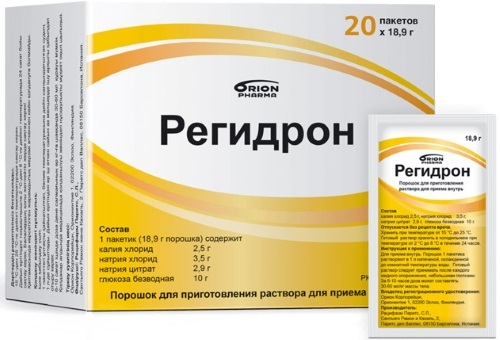
- Rehydron (against diarrhea and diarrhea).
For severe headache in a child
Children with an overdose of Nurofen may also experience headaches of varying severity. With migraine pain caused by taking the drug, symptomatic therapy is also carried out. Pain relievers are ineffective or ineffective at all. In this regard, all actions are aimed at removing the excess content of the main agent, the reception of which caused the poisoning.
The child is prescribed a plentiful drink. In more severe cases, various detoxification solutions of a wide spectrum of action are introduced - sodium thiosulfate, Unithiol. Additionally, multivitamin complexes or glucose can be prescribed. As a supplement at home, various infusions made from raspberries, rose hips or linden can be recommended.
When the pressure drops
With a sharp drop in blood pressure, immediate treatment is also required. First of all, gastric lavage is performed, after which sorbents are prescribed. After removing the excess content of the active component of the agent, various drugs are used to stabilize blood pressure.
In case of a sharp drop in pressure, apply:
- adrenomimetics;

- adaptogens;
- anticholinergics;
- nootropic drugs.
In addition, various multivitamin complexes can be used. Physiotherapy is also carried out - electrophoresis with the use of novocaine, potassium iodide, ultraviolet exposure to the skin, microwave therapy. In this case, the child needs constant supervision and peace (good rest, sleep).
In case of malfunctioning of the heart
After standard procedures (washing, taking sorbents), medications are prescribed that affect the work of the cardiovascular system.
With the development of tachycardia, the following groups of drugs are used:
- Β-blockers;
- cardiac glycosides;
- drugs that block sodium and potassium channels;
- anesthetics (lidocaine).
When bradycardia occurs, medications are prescribed that have a stimulating effect on heart contractions - sympathomimetics, anticholinergics. The funds are used in emergencies and are not suitable for daily use.
Possible consequences of an overdose, emergency assistance
An overdose of Nurofen in a child can cause consequences that, in addition to medical therapeutic measures, require mandatory first aid.
With the development of this disorder, the child must be laid on the bed and slightly raised his head to facilitate breathing. In this case, it is necessary to provide a sufficient amount of oxygen. In a hospital setting, mechanical ventilation (artificial lung ventilation) can be used.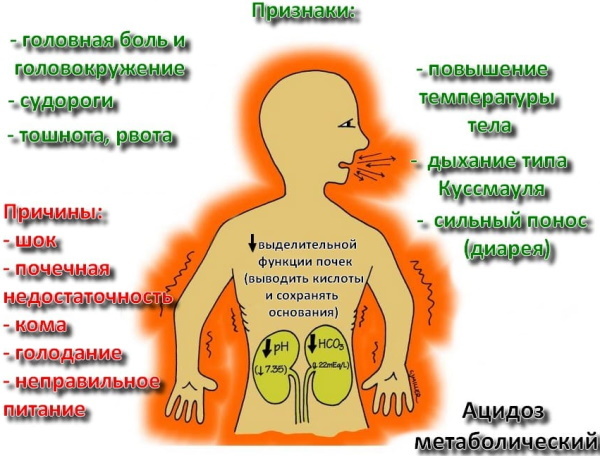
The child also needs to take a blood test to determine the concentration of gases in the blood. During therapy, it is necessary to systematically monitor cardiac activity. If the child has diagnosed diabetes mellitus, 1 dose of insulin is required. At a reduced pH, sodium bicarbonate injections are injected. In this case, it is necessary to constantly monitor the pH concentration so that an overdose of this substance does not occur.
Additional therapeutic measures (in a hospital setting):
- tracking all vital body functions;
- conducting an ECG;
- hemodialysis.
It is also necessary to conduct a blood test for potassium content.
Atrial fibrillation
If this violation occurs (before the arrival of an ambulance), it is necessary to adhere to the established rules.
Recommendations:
- the child must take a sitting position;
- take off outerwear and unfasten all buttons;
- provide a rush of fresh air;
- lightly wipe your face with a handkerchief soaked in plain water;
- breathing should be from the abdomen;
- take 1 / st. ordinary water and dilute 20-30 drops of Corvalol in it.
It is forbidden to give the child nitroglycerin before the arrival of the medics.
 Specialists at home should take blood pressure measurements. In severe cases, and only if indicated, electro-pulse therapy can be performed, which will restore a normal heart rhythm. Before this, the child is given intravenous analgesics and sedatives.
Specialists at home should take blood pressure measurements. In severe cases, and only if indicated, electro-pulse therapy can be performed, which will restore a normal heart rhythm. Before this, the child is given intravenous analgesics and sedatives.
Antiarrhythmic drugs, as well as cardiac glycosides, are used only if absolutely necessary and only with the permission of a doctor.
Acute renal failure
An overdose of Nurofen in a child can also lead to acute conditions, including renal failure.
With renal colic, the child can be placed in a hot bath (in the absence of contraindications and only in a sitting position). In extreme cases, it is allowed to apply a hot heating pad to the painful area. Such techniques are used with extreme caution, since they can provoke a worsening of the condition.
In this case, all patients with acute attacks are required to comply with bed rest. As a supplement, it is allowed to use antispasmodics (Drotaverin, Papaverine) or other combined drugs that have an antispasmodic effect.
It should be borne in mind that pain relievers are not used in the development of pathology, since they can interfere with the diagnosis. In a hospital setting, therapy is carried out that restores the outflow of urine and helps to remove toxic substances. Additionally, treatment of hemodynamic disorders is prescribed. In a hospital setting, injections such as dopamine, heparin, glucose are used.
Stop breathing
Respiratory arrest is an extremely dangerous condition that requires an immediate call of a medical team of specialists and first aid.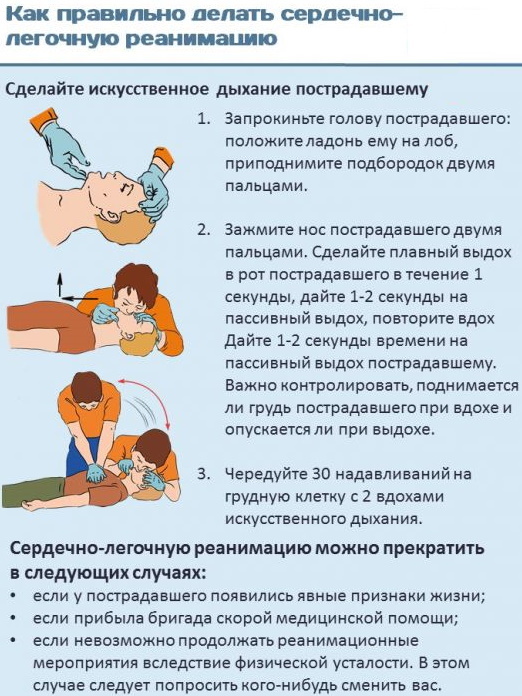
Algorithm of actions:
- Check breathing and feel for pulse.
- Unbutton buttons, belt and other dragging items of clothing.
- Artificial respiration (with loss of consciousness and complete cessation of breathing). To do this, pinch your nose with two fingers, press your lips against the child's mouth and release the air. Actions are carried out up to 30 times.
After the restoration of the state, you must wait for the arrival of an ambulance. It is strictly forbidden to give any food or drink to the victim. Also, you cannot raise the child's head and put anything soft under it.
It is also not recommended to use any drugs (only in the case of chronic diseases of the respiratory system).
Coma
Coma is a state between life and death and is characterized by complete loss of consciousness, absence of any reflexes, impaired breathing depth and pulse rate. When this violation occurs, urgent assistance of specialists is required, since it can be fatal.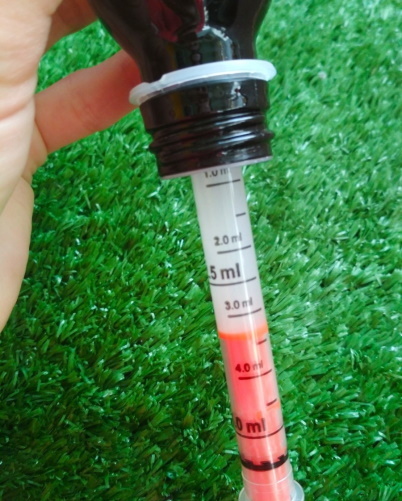
First aid algorithm:
- Turn the baby on its side.
- Lower your upper body slightly.
- Open the victim's mouth and clamp the lower jaw, constantly holding it.
- Assess the patient's condition - skin color, depth of breathing, pulse rate.
- Ensure the passage of the respiratory tract (if the child has contents in the mouth - sputum, vomiting, stomach contents). Mandatory ventilation is required.
- Assess visual function - lift the eyelids and examine the pupils.
In some cases, a coma may be accompanied by the development of seizures. If such signs occur, it is necessary to hold the victim's tongue so that he does not bite him. You should also support your head and lower jaw to avoid injury.
When taking Nurofen, it is necessary to strictly adhere to the established dosage rules and carry out therapy under the supervision of a doctor, especially in childhood. If you develop any negative signs associated with an overdose of the drug, you should immediately call the ambulance team.
Video about the active substance of Nurofen
The truth about ibuprofen:



